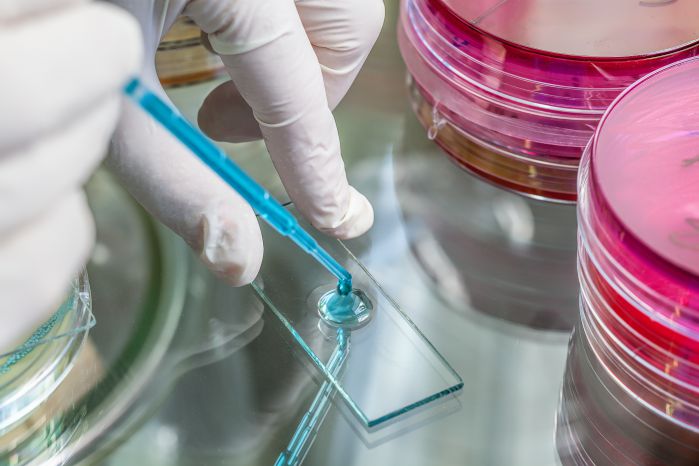Slide 1 of 4: Introduction
Authors: Ronald J. Comer, Princeton University and Jonathan S. Comer, Florida International University

Press the Next button to start this activity
Slide 2 of 4: 42.1 LSD and Current Research
This video examines the question of whether it is possible for hallucinogenic drugs to have some positive mental health benefits. In the video, you will see the author Ayalet Waldman discuss how “microdosing” LSD helped her overcome a suicidal depression. You will also see researchers and participants discuss a study in which cancer patients took the hallucinogen psilocybin to overcome feelings of anxiety. The video also explores the history of the psychological study of hallucinogenic drugs, its decades’ long illegality, and recent renewed research attention.
- Chapters
- descriptions off, selected
- captions settings, opens captions settings dialog
- captions off, selected
- English Captions
This is a modal window.
Beginning of dialog window. Escape will cancel and close the window.
End of dialog window.
This is a modal window. This modal can be closed by pressing the Escape key or activating the close button.
This is a modal window.
LSD and Current Research
AYELET WALDMAN: Lexa, Effexor, Zoloft, Trazodone—
JOURNALIST: Ayelet Waldman is no stranger to drugs.
AYELET WALDMAN: I'm not going to get them all.
JOURNALIST: Lexapro? Wellbutrin?
AYELET WALDMAN: Lexapro, Wellbutrin—oh my goodness, there you are.
JOURNALIST: Diagnosed with a mood disorder, this author and mother of four had tried everything.
AYELET WALDMAN: I was profoundly, profoundly depressed. Suicidally depressed.
JOURNALIST: As bad as it ever—
AYELET WALDMAN: No, I had never been like that in my life.
JOURNALIST: That's when she turned to a drug that might blow your mind.
AYELET WALDMAN: Kids, mommy is going to tell you all about the first time she tried acid.
JOURNALIST: That's right, LSD. In secret, Waldman actually began taking a minuscule amount every three days. It's called microdosing, and it's a controversial yet growing trend among the Silicon Valley crowd. But for her, she says, it worked.
AYELET WALDMAN: You don't hallucinate. You don't see anything unusual. But it just—the best way I can describe it is a little more cheerful, and a little more effective at work. Like, a little more productive.
JOURNALIST: So productive, in fact, she wrote a book about her mind-altering experiment.
AYELET WALDMAN: Good girl. [LAUGHING]
JOURNALIST: And most importantly, her suicidal thoughts disappeared. But there was a catch. After a month, she ran out of the small supply she'd gotten hold of.
Why did you stop microdosing?
AYELET WALDMAN: Because it's illegal. If it weren't illegal, I would still be doing it.
JOURNALIST: Taking LSD, even a microdose of it, is still against the law and potentially dangerous. But once upon a time LSD, and psychedelics like it were considered potential wonder drugs. Throughout the 40s, 50s, and into the 60s scientists studied them to understand mental disorders like schizophrenia, and to treat anxiety, depression—even alcoholism.
[LAUGHING]
MAN: Oh, excuse me.
[LAUGHING]
[ROCK MUSIC]
JOURNALIST: But when the drugs left the labs and started hitting the streets, and Timothy Leary preached
TIMOTHY LEARY: Turn on, tune in, and drop out.
JOURNALIST: The bad trips and even worse headlines that followed changed their reputation. And then.
RICHARD NIXON: This nation faces a major crisis in terms of the increasing use of drugs, particularly among our young people.
JOURNALIST: The Controlled Substance Act led to a more than three decades long ban on all psychedelic research. Since 2003, however, the FDA has allowed for a few clinical trials of illegal hallucinogens—drugs like psilocybin, the psychedelic ingredient found in so-called "magic mushrooms." Trials done in a safe, controlled setting, of course. Do not try this at home.
TONY BOSSIS: This is the couch where people have the experience.
JOURNALIST: This is a very special couch.
TONY BOSSIS: It's a magic couch.
JOURNALIST: In 2016, Tony Bossis of New York University, along with researchers at Johns Hopkins University, published their findings of what a one-time dose of psilocybin can do to treat anxiety and depression in cancer patients.
TONY BOSSIS: In this study, anxiety and depression reduced dramatically immediately after the experience.
DINAH BAZER: I just wanted this terrible daily anxiety to go away.
JOURNALIST: Dinah Bazer beat ovarian cancer back in 2010, but the fear of it returning convinced her to volunteer for the study. In this treatment room, she was given the psilocybin and her life-changing trip began.
DINAH BAZER: I saw my fear, and it was a black mass under my ribs. It wasn't cancer. It was the fear itself. And it made me so mad. I was just—I was furious, and I screamed at it to get out. And as soon as I did that, it was gone.
JOURNALIST: When the drug wore off, the anxiety about her cancer returning was gone—still is. What remains, she says, is the powerful memory of that symbolic experience.
TONY BOSSIS: This medicine they take once is out of their system in a few hours, but it generates a three to four hour incredible transcendent experience. And it's the memory of that experience that recalibrates how they view life and death and their existence, very spiritual insights.
JOURNALIST: If all that sounds a bit far out, scans have shown psychedelics may increase connectivity among different regions of the brain—areas that normally don't communicate with each other.
TONY BOSSIS: Maybe it's time to take a sober, careful scientific look at these medicines. To revisit, are they helpful? Are they safe? Are they effective?
JOURNALIST: With more clinical trials on the horizon, researchers hope to open more minds about the potential of psychedelic drugs—one trip at a time.
Slide 3 of 4: 42.2 Check Your Understanding
Instructions:
Answer the questions based on the video and your reading of the entire chapter.
Slide 4 of 4: 42.3 Activity Completed!
Activity results are being submitted...